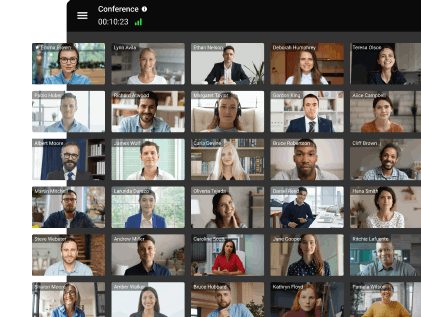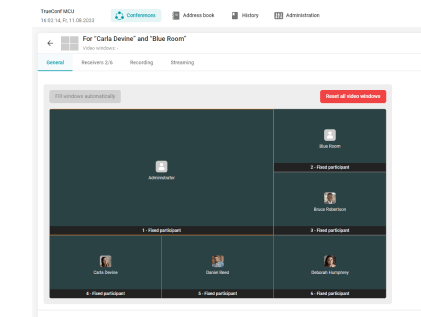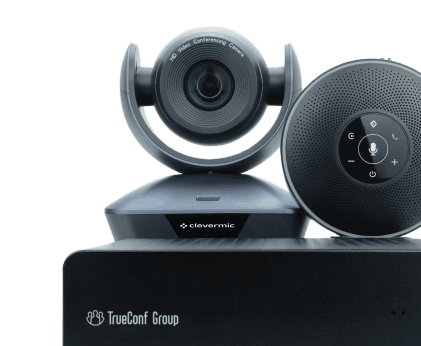

Video conferencing is a key communication channel in the modern world, offering efficiency and comfort in both professional and personal environments.
In the material we will consider
The importance of video conferencing, its main advantages for interaction in teams working in remote and hybrid formats.
Video conferencing is a communication system that enables users to organize personal video calls and group conferences. When team members are geographically dispersed, telecommunication technologies enable real-time interactive exchange of audio and video data among participants. Communication becomes more convenient and efficient thanks to a wide range of features, including collaboration tools such as presentations, screen sharing, and annotations.
Many companies worldwide use video conferencing to ensure comfortable interaction among employees separated by long distances. The Internet's widespread availability enables online communication, allowing teams to quickly solve emerging issues, discuss complex business tasks, and contact business partners. Video conferencing platforms often include a built-in messenger, which significantly speeds up the resolution of most challenging situations.
The problems that arose during the pandemic, related to the inability to personally visit the office, led to the emergence of remote work as a new form of employee employment: this shift made video conferencing a real necessity.

reported the benefits of working remotely

of employees will consider leaving their employer if required to return to the office full-time

believe that the remote format has increased their productivity.
The benefits of remote communication, such as reduced rental property costs and travel expenses, have become particularly noticeable over time and have attracted the attention of many employers.
Among the employees who switched to working from home, there was a sharp increase in productivity, prompted by flexible schedules and an improved work-life balance. Among the employees who switched to working from home, there was a sharp increase in productivity, prompted by flexible schedules and an improved work-life balance.
The on-premises deployment of the video conferencing model implies that all the necessary equipment and software for virtual meetings are located directly on the enterprise network. The organization has full control over its video conferencing system. The company handles the purchase, installation, and maintenance of equipment internally, ensuring the security of corporate communications.
The advantages of the on-premises model include improved control over data and systems, specific customization to customer requirements, and the ability to use existing IT infrastructure. This approach, however, may require significant installation costs.
The cloud-based video conferencing model involves storing all data and software on remote servers. Users access the system through the Internet. Thus, the processing and storage of all information takes place in the virtual cloud, and not on the equipment of the organization itself.
Cloud services have become increasingly popular among businesses over the past decade, due to lower initial costs and reduced infrastructure requirements. Nevertheless, several significant risks are associated with dependence on an Internet connection and the high probability of personal data leakage.
The hybrid model of video conferencing solutions combines the advantages of on-premises and cloud approaches. The organization deploys the main data processing server locally, providing increased control and security. Cloud services manage and flexibly scale the platform, ensuring continuous communication and employee productivity even during connection problems.
It must be understood, however, that in most cases, a hybrid model is a turnkey solution that adapts to the specific needs of each enterprise. Most often, large companies turn to these video conferencing systems, which need to unite many employees through corporate communication.
Regarding the functionality of video conferencing systems, it's important to clarify that video communication sessions are typically divided into two types based on the number of participants: personal and group.
Artificial intelligence has become not just a trend but an undeniable vector of development that has influenced many modern video conferencing solutions.
Among the numerous machine learning-based technologies, «intelligent capture» proposed by Microsoft Corporation stands out.
Thanks to this development, in 2019 it became possible to make the speaker more transparent when overlapping with broadcast content.
Agora has proposed a technology based on artificial intelligence that analyzes video data and participants' emotions in real time, then reports the findings to the interlocutor.
This SDK is designed to provide a timely opportunity to call for medical help in case of a sharp deterioration in well-being.
«EmbodyMe» also developed an interesting idea based on machine learning. The developers allow users to virtually change their hairstyle, wear suitable clothes, and even choose appropriate makeup during video communication.
This technology works in real-time, saving users from having to prepare for online meetings in advance.
With the help of artificial intelligence and thoughtful video capture, EmbodyMe can transform a person from a video into any character. This latter function is not particularly useful for large companies and offices, but it presents an intriguing concept.
Various video conferencing systems are available on the market today, but it's important to note that they differ in their features and capabilities. The right solution should be both easy to use and secure enough to meet your needs without risking data leaks.
As mentioned above, when conducting corporate video conferences, confidentiality is paramount. Attackers must be prevented from accessing data, even during transmission. That is why TrueConf Server has several levels of security implemented simultaneously.
If you have a major business meeting or a product presentation for a client, you need to choose a reliable solution. TrueConf supports SVC (Scalable Video Coding) technology, which allows the video conferencing server to easily select the optimal video image quality, resolution, and frame rate based on the available bandwidth of the communication channel.
The convenience of administration and management, as well as detailed analytics, are a necessary part of the video conferencing platform. Thanks to the rapid deployment of within your corporate network and its easy administration, you can start conferences in 15 minutes without wasting time on additional settings.
The Gartner® Magic Quadrant™ is an annual research report in the technology field, providing essential insights for selecting the right video conferencing solution. is a developer without global analogues, monitored by analytical agencies Gartner, IDC, and Frost & Sullivan.
The scalable video conferencing platform for large businesses and telecom operators.
Learn moreTrueConf Group is a hardware video conferencing endpoint designed for medium and large meeting rooms.
Learn more







